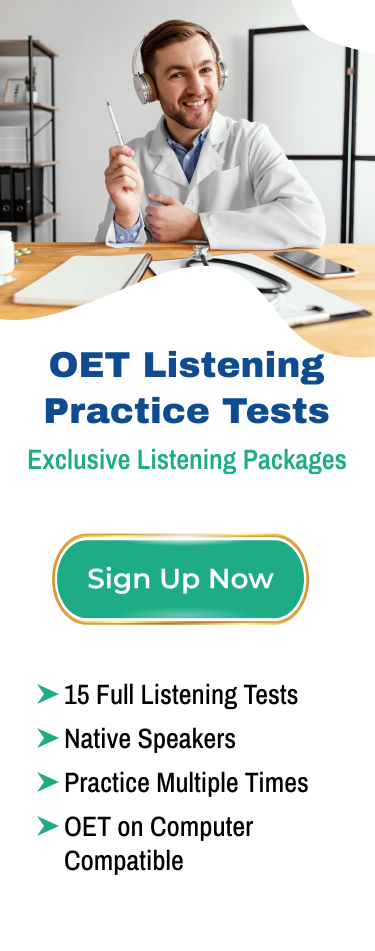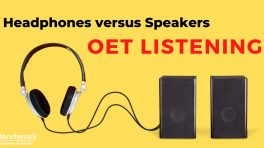Ultimate Guide to OET Listening Part B and C
- 12 Comments


Many candidates struggle with the listening component of the OET. In the OET Listening sub-test, there are 42 questions which are spread over 3 parts – Part A, B and C. This article will concentrate on the skills required to answer questions in Part B and C. If you are interested in how to answer all questions, you can read more about OET Listening Part A guide.
The good news is Part B and Part C consist of multiple-choice questions. Here is a break down for you.
| OET Listening sub-test | ||
|---|---|---|
| Section | No. of questions | Question type |
| Part A | 24 questions | Fill in the blanks |
| Part B | 6 questions | Multiple choice (choose from 3 options – A, B or C) |
| Part C | 12 questions | Multiple choice (choose from 3 options – A, B or C) |
For each question in Part B and Part C, you have to choose one answer from a choice of 3 options (Option A, B and C). This means that even if you are not sure of your answer, you can still make a pretty good guess and you have a 1/3 chance of getting it right.
This is what you can expect from Part B and Part C:
| OET Listening – Part B & C | ||||
|---|---|---|---|---|
| Section | Number of listening extracts | Example of extracts | Number of speakers/voices | Number of questions |
| Part B | 6 short extracts |
| 1 or 2 speakers |
|
| Part C | 2 long extracts |
| 1 or 2 speakers |
|
The skills required to answer Part B and Part C are almost similar. You will need to listen for gist, opinion, and purpose. This means that you need to have a clear understanding of what the speaker is talking about and you are not just picking up specific words or phrases (although you still need to listen carefully to specifics as these will help you with your overall understanding).
Listening Strategy #1:
READ THE QUESTIONS BEFORE YOU LISTEN
Before we proceed to the listening portions, one very IMPORTANT thing you need to remember is to use the reading time well. This is what your test instructions will look like:
Part B
In this part of the test, you’ll hear six different extracts. In each extract, you’ll hear people talking in a different healthcare setting
For questions 25 to 30, choose the answer (A, B or C) which fits best according to what you hear. You’ll have time to read each question before you listen. Complete your answers as you listen.
Part C
In this part of the test, you’ll hear two different extracts. In each extract, you’ll hear health professionals talking about aspects of their work.
For questions 31-42, choose the answer (A, B or C) which fits best according to what you hear. Complete your answers as you listen.
Now look at extract one.
Extract 1: Questions 31-36
You hear an interview with ….
You now have 90 seconds to read questions 31-36.
For Part B, before each extract is played, you have about 15 seconds to read one question and the 3 options given. For Part C, you have 90 seconds to read 6 questions and their corresponding options. Use this time wisely. It will help you to look out for key words when you listen to the audio.
For instance, take a look at Example 1.
Example 1
30. You hear a patient’s family member expressing concerns to a nurse.
What does the nurse say to prioritize in this case?
- Finding a nursing home close to the patient’s house
- Taking the patient home for treatment
- Respecting the patient’s desires
The key word in the question is ‘prioritize’. What does that mean? It means that something should be given top priority over everything else. Think about it! What are some words you should be looking for as you listen? Here are some we can think of:
- it’s a priority
- do this first
- most important
- primary
- top of the list
- above all else
Now, look at the options, A – C. It is most likely you will hear ALL the options mentioned. You just need to listen for the option that has been identified as the priority.
Now, listen to the audio sample for this portion of the test and let’s see if our predictions are correct. Remember to keep an open mind and listen carefully because sometimes you may predict wrongly and the answer may be something unexpected.
So, what word was used to signify ‘prioritize’? Yes, the nurse said ‘the most important’. So what did the nurse say was the most important? It was ‘talked to your husband about his wishes’. So the answer should be ‘C. Respecting the patient’s desires’.
Now, you try.
Exercise 1
27. You hear two nurses discussing a training they took on vaccinations.
What do the two nurses agree on about the training?
- The usefulness of a review on certain issues
- That it was not necessary to include some topics
- That not everyone needed to take the training
Exercise 2
28. You hear part of a training on communication between providers.
What will be the priority of the new role discussed?
- To improve communication between doctors and patients
- To improve communication between patients and nurses
- To improve communication between doctors and nurses
Listening Strategy #2:
IDENTIFY THE SPEAKERS CORRECTLY
In Parts B and C of the OET Listening sub-test, you may sometimes hear 2 voices in the audio recording. The first thing you need to be very sure about is who the speakers are. Look at this the question in Example 2.
Example 2
26. You hear a nurse asking a doctor for help with a patient.
What does the doctor suggest be done with the patient?
- To let him rest and see if the pain continues
- To perform an ultrasound to rule out a fracture
- To quickly eliminate a more serious possibility
If you look at Example 2, there are 2 speakers – a doctor and a nurse. The question is ‘What does the doctor suggest…’ So, you need to know which voice you hear is the doctor’s voice. Otherwise, you will be listening to the wrong person. In the test, usually, the speakers’ roles will be made very clear from the beginning.
Now, listen to the audio sample for the above question and identify whether the male or female voice is the doctor.
So, in Example 2, the male voice is the doctor. At the beginning, the female nurse says ‘Hello, Dr Jones’. That is your clue that the second voice (male voice) is the doctor.
In this question, the answer is ‘C. To quickly eliminate a more serious possibility’.
NOW, YOU TRY.
Exercise 3
27. You hear a nurse talking to another nurse about a patient’s treatment.
What does the female nurse want the male nurse to correct?
- How accurate he is in updating the patient’s file
- How often he checks on the patient’s condition
- How compliant he is in following instructions
Exercise 4
30. You hear a conversation between a GP and a neurologist.
The GP has contacted the neurologist primarily because…
- There was some information left out of the patient’s file.
- She is very worried about the prognosis of the patient.
- She was concerned that the notes contradict the patient’s symptoms.
LISTENING STRATEGY #3:
LOOK FOR WORDS OR PHRASES WITH THE SAME MEANING
Sometimes, you will hear the speaker use the same words as the ones in the question. However, sometimes, different words may be used, so you really need to be prepared for this.
Look at example 3.
Example 3
33. What is the objective of the first treatment approach being researched?
- To have children build up tolerance by starting to eat a wider variety of foods
- To have children build up tolerance by starting to eat small amounts of the allergen
- To have children build up tolerance by starting to eat large amounts of the allergen
The answer to Example 3 is ‘B. To have children build up tolerance by starting to eat small amounts of the allergen’. However, what you heard and what you got in the question and answer were quite different. Here is a summary:
| What you SEE in the Q & A option | What you HEARD |
|---|---|
| ‘objective’ | goal |
| B. ….starting to eat small amounts… | ‘…gradually increasing the amount they eat’ |
NOW, YOU TRY.
Exercise 5
28. You hear part of a post-surgery follow-up at a GP practice
What does the patient want to know about?
- The cause of the pain in his belly.
- The time period before resuming activity.
- The reason he still needs to be taking normal routines slow.
Exercise 6
30. You hear a hospice nurse explaining intake protocol for new patients.
The protocol is designed to
- Help the patient make decisions about his/her own health care
- Support the family of a patient to make decisions about care
- Give information about the purpose of hospice and palliative care
LISTENING STRATEGY #4:
INTERPRET WHAT YOU HEAR
Finally, the most challenging part of the OET Listening sub-test is having to listen and interpret what you hear at the same time. This means you have to try and guess that the speaker’s opinion is.
Look at Example 4.
Example 4
37. According to the speaker, the most important challenge facing dermatology is…
- The financial aspect of seeking treatment
- The low priority placed on the specialty
- The lack of contributions made by the specialty
The answer to Example 4 is ‘B. The low priority placed on the specialty’. However, you do not hear this explicitly at all in the audio other than the word ‘priority’. Instead, you are expected to interpret what you hear. We sum it up for you here.
| What you HEARD | Logical interpretation |
|---|---|
| …priorities focus on large scale public health issues such as hypertension, diabetes, obesity, and depression | Since the focus is on other things, and NOT dermatology, then dermatology must be given LOW priority |
| …we must make the case for dermatology. | ‘We must make the case for dermatology’ means that we need to make an effort to make it more prominent, so that means it must have been given LOW priority in the first place |
NOW, YOU TRY.
Exercise 7
37. Why does the presenter give statistics about tooth decay?
- To help the audience understand the scope of the problem
- To help the audience understand the cost of the problem
- To help the audience understand possible short-term solutions
Exercise 8
27. You hear part of a training about sports nutrition.
Who is the audience for the training?
- The training is for professional athletes training for competitive sports
- The training is for general practitioners involved in helping athletes recover from sports injuries
- The training is for dietitians who may be referred by a general practitioner
***
And there you have it! Simple tips to help you in Part B and Part C of the OET Listening sub-test. You will need to practice more in order to get used to it. As you do more practice, you will get better at it so that by the time you sit for the test, you are comfortable utilizing all the listening skills required for the test. If you need sample OET Listening tests, check out the Benchmark OET Listening Practice Tests.
Additionally, for OET Preparation Material for Nurses , OET Preparation Material for Doctors, OET Preparation Matrials For Physiotherapy and OET Preparation Matrial For Pharmacy these resources can provide valuable practice for both the listening and other subtests.















these example questions were very helpful to understand part B question type.
Thank you so much
Many thanks. For more practice, we highly recommend our 15 full listening tests.
This listening text is very helpful.i belief by the time I applied to this I will be able to achieve my goals.
We need more practice material
Hi, Please visit this link
Really helpful can u include more part b and c question and answers. It would be better to get good score
OET Reading Practice
We need more practice material
Please visit this link
These sample test’s questions are well organised & help me very well. Thank you very much all the team & hoping some more practice materials.
HELLO, THANKS A LOT FOR ALL THIS PRECIOUS STRATEGIES.
PLEASE, COULD YOU GIVE US THE STRATEGIES HOW TO LEARN TO READ QUIKER AND UNDERSTAND THE QUESTION TOO
I MEAN TO IMPROVE THE READING, BECOUSE THE TIME IS SO SHORT? IVEN FOR READING TEST AS WALL. THANKS AGAIN
we need more practice within the limited time frame of the examination.